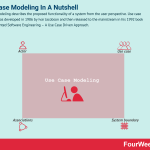Use Case Modeling In A Nutshell

Use case modeling describes the proposed functionality of a system from the user perspective. Use case modeling was developed in 1986 by Ivar Jacobson and then released to the mainstream in his 1992 book Object-Oriented Software Engineering – A Use Case Driven Approach.
Understanding use case modelingUpon release, the book popularized use case modeling as a technique to capture functional requirements in software development.
Use case modeling can be applied in the following scenarios:
Capturing system requirements.Driving the implementation and generation of test cases.Specifying the context of a system.Validation of a systems architecture.Developed by analysts with domain experts.The core elements of a use case modelAs a minimum, the use case model contains the following basic elements that are graphically depicted to show the relationship between each element:
Actor – who is using the system? Actors encompass both human users and other computer systems. They use a use case to perform some piece of work that is of value to the business. The overall role and scope of each actor in the system are defined by the set of use cases they have access to.Use case – what do the actors want to achieve? A use case describes how the system should respond under various conditions to a request from an actor to deliver a specific goal. Think of a use case as representing a discrete unit of meaningful work, such as the fulfilment of a new order or the registering of a new account. A discrete use case may incorporate the functionality of another use case or extend a use case with its own behavior.Associations – or the relationship between actors and the particular use cases they interact with. System boundary – which defines the system of interest with respect to the world around it.The core elements of a use case descriptionUsing elements of the use case model, a use case description provides a detailed, step-by-step account of the interaction between the actor and the system. This sequence of steps is called a scenario.
Ultimately, the account should clearly show how the actor must initiate an action to derive value and achieve a goal.
To that end, it should contain the following:
Title – which must communicate the goal of the use case. In the case of a student wanting to sign up for a volleyball class, the title may be “Register Student for Volleyball Class”.Description – or a summary of what the use case does.Actors – again, these are the people or systems who interact with the use case.Preconditions – what needs to be in place before the use case can commence?Postconditions – what conditions must be met for the scenario to end, either successfully or unsuccessfully?Path – or the step-by-step interaction between the actor and the system, divided into three types. The primary path is the most commonly taken route to a successful conclusion. The alternate path is a less commonly used route to the same conclusion. The exception path leads to an unsuccessful conclusion and may incorporate an error message or further instruction.Date of creation and revision history – this chronology helps determine how old the use case is when undertaking document analysis.Priority and frequency of use – how important is the use case? How often is it executed? Both are useful in solution planning.Key takeaways:Use case modeling describes the proposed functionality of a system from the perspective of the user.At the very least, a use case model should contain four basic elements: actor, use case, associations, and system boundary.Use case modeling necessitates that a use case description is written. This is a series of steps that provides an account of the interaction between the actor and the system.Read Next: SWOT Analysis, Personal SWOT Analysis, TOWS Matrix, PESTEL Analysis, Porter’s Five Forces, TOWS Matrix, SOAR Analysis.
Main Free Guides:
Business ModelsBusiness StrategyBusiness DevelopmentDigital Business ModelsDistribution ChannelsMarketing StrategyPlatform Business ModelsTech Business ModelWhat Is EntrepreneurshipThe post Use Case Modeling In A Nutshell appeared first on FourWeekMBA.



